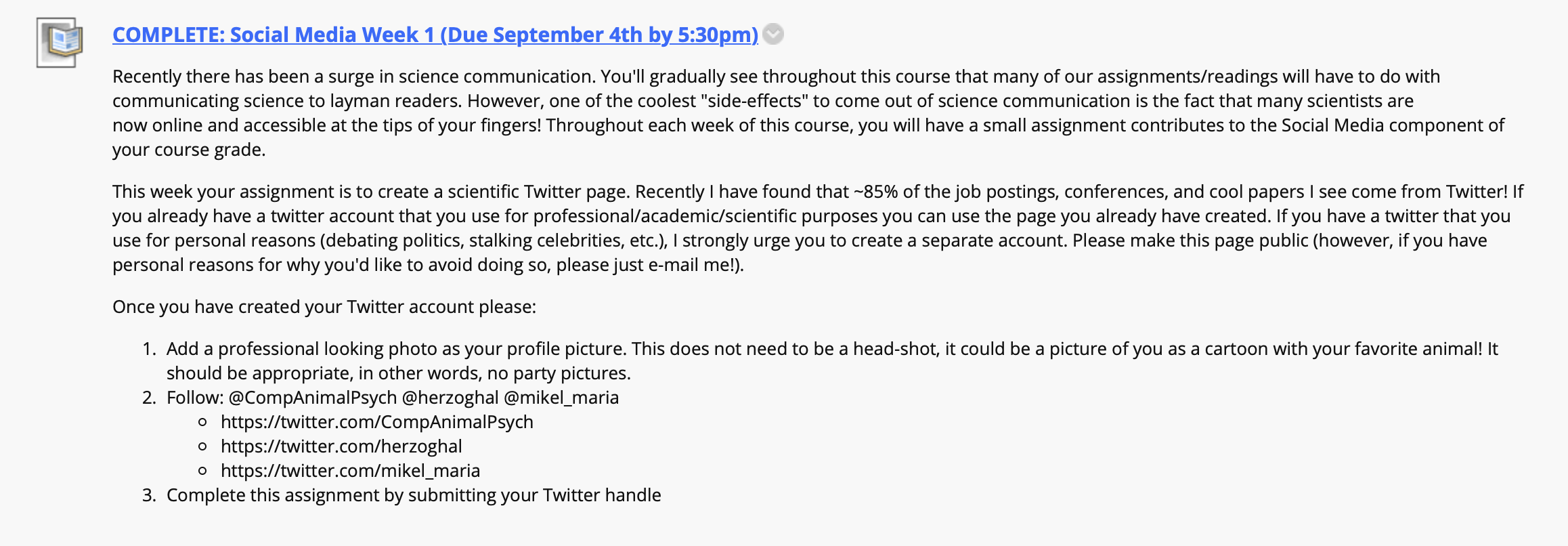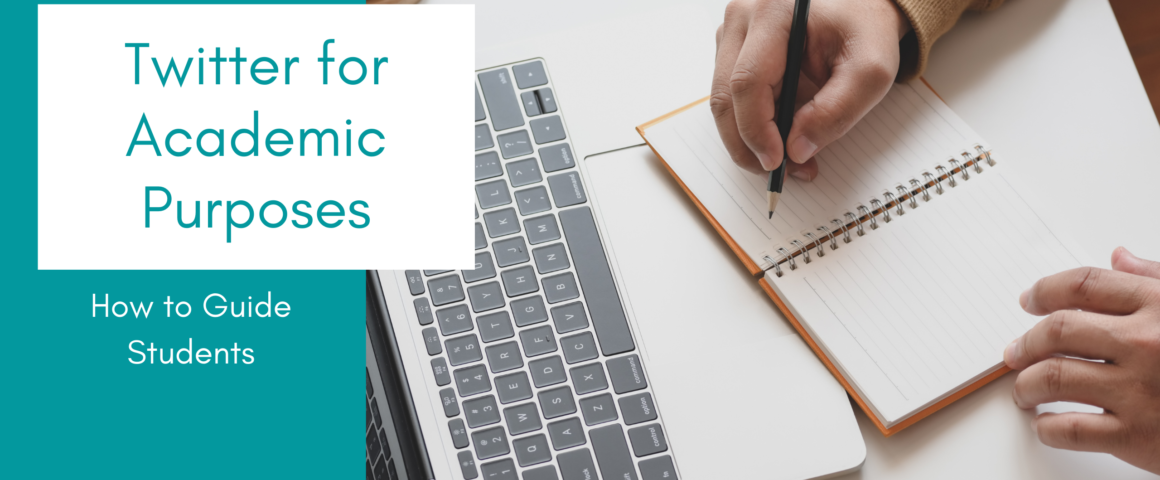Introduction
Recently there has been a surge in scientific communication (sci-comm), meaning that researchers and science communicators are actively disseminating peer-reviewed research in a manner accessible to the general public. Perhaps one of the most exciting features of this movement is that many scientists are now online and accessible via appropriate social media platforms at the tips of students’ fingers. In my field, Animal Behavior, there is an active Academic Twitter community that happily shares materials, discusses issues with the general public, and guides students looking for additional information. For this reason, I wanted my students to be comfortable engaging online with Academic Twitter, learning proper sci-comm practices while indirectly boosting their own online professional profile.
This real-world implication not only benefits learning within the classroom in terms of writing and critical thinking skills, but also invokes additional indirect benefits for professional development. With an appropriate profile, students can use their Academic Twitter long after use in the classroom to pursue career opportunities, network, share materials and resources, as well as engage in sci-comm.
Description of the Assignment and Methodology
Throughout each week of the semester, I guided my Companion Animals in Society students in understanding what Twitter is and how it can be used for professional and academic purposes. These low stakes, weekly assignments began simply with the creation of a Twitter account. I explained to my students that my ultimate goal was to set them up with a professional profile which could help them locate fun and beneficial opportunities within academia and professional industries. While some already had Twitter profiles, I encouraged them to think about how they would like to be seen online. While many academics use their Twitter profile simply for science, others incorporate more personal information in their Tweets. Therefore, I allowed them the opportunity to create a new, professional only Twitter account, or to combine their professional identity with their current profile. It is important to note that Twitter can be set to private, and some students may not want to be present online. As this assignment was facilitated via the closed learning management system BlackBoard where I asked students to share screen-shots of their Tweets, however, any students who were uncomfortable with the idea had the chance to simply write out what they would have done and what they found online, without creating an actual account. I will note that all students created and/or utilized their own Twitter accounts, and all were set to public.

Once the accounts were created, I guided the students in creating their profile. I provided them with tips and suggestions on what a professional photo might entail, and given the topic of the course, encouraged them to post a profile picture with their pet. I also provided them with the Twitter accounts of various other science communicators which they could use as an example.

Following up with the creation of the Twitter account, I provided my class with feedback on their bio. I asked them to find various Twitter accounts online and highlight what they liked and disliked about them. From here, I asked them to attempt to create their own bio, using their own suggestions. Before adding the bio to their Twitter pages, I provided them with feedback, making suggestions about how they might want to tag a certain research group they were involved in and/or add relevant links to a personal website.

Every week, I asked the students to become a bit more familiar with Twitter. It’s important to note that I didn’t ask them to post any Tweets until the middle of the semester. Many students are concerned about posting online, and I wanted them to feel confident about this process. Thus, during the first few months, I only wanted them to follow organizations, scholars, other undergraduate/MA/PhD students, journals, and more. I offered suggestions on how to find Twitter accounts to follow, but I did not require them to follow specific accounts. I only required that they share why they selected these specific profiles, and this justification was done privately via Blackboard. The reason for this approach is that students have varying interests, career goals, and opinions. Therefore, I wanted them to be able to create a Twitter account for themselves that would be relevant to their future, not just my classroom.

Midway through the semester, I guided the students through the process of creating a Tweet. Twitter can be a scary place, especially if you’re following all your academic idols. I allowed my students to draft a Tweet and submit it to Blackboard (privately) for feedback before actually posting it to their accounts online. I asked them to think about the point of their message and what they were trying to communicate. For some, this meant retweeting another previously posted tweet with a comment. For others, this involved sharing a link to a sci-comm piece but creating their own Tweet about the piece itself. The content within the tweet was completely up to them, but needed to relate to the subject of the course somehow.
As the final weeks of the course presented themselves, I let my students follow, tweet, and contribute to conversations in the Twittersphere. While I let them have free rein on what they wanted to communicate and engage with, I still had very clear and concise instructions. First, they had to post on Blackboard to let me know what they had done. Generally, this involved having them post a screen-shot of their contribution, while providing two to three sentences about what this particular Tweet meant to them, how they hoped it would help others, and what they changed, content-wise, in order to make it accessible to a general public. This justification was never posted on Twitter. It was privately shared between the student and myself and allowed me to evaluate the comprehension of the material at hand, while also allowing the student to engage in professional development skills and practice science communication in a real-world setting.

Final Results and Impact
At the end of the course, I asked my students to reflect on their experiences using Twitter. Many of them noted that while they were originally not enthused by the idea of engaging in social media for class, they thoroughly enjoyed the scaffolded semester-long assignment for a variety of reasons. Below I present an overview of the three main implications of the assignment.
First and foremost, the assignment was consistent, concise, and feasible. From Week One to Week Fifteen each student was aware that a low-stake, Twitter-based assignment would need to be completed. It was also very easy for them to post online as the assignment took advantage of their pre-existing social media use. They did not need to be at their computer, as they could easily complete this work from their phone while on the subway or waiting for a friend.
Secondly, the assignment allowed students a guided process in which critical evaluation skills of online presented content were put to the test. While I provided guidelines and examples in every set of assignment instructions, students were asked to curate content that they personally found most interesting and trustworthy. This meant that students were generally interested in the subject matter while they learned the foundations of sci-comm best practices. As they followed accounts related to journals, articles, and news and media sources, their Twitter feed quickly turned into a stream of popular information curated to their own liking with up-to-date news on their topic or topics of choice. Additionally, students were not only asked to select posts, blogs and articles, but they were asked to explain why they selected them. This process allowed them to act both as a consumer and a producer in assessing sci-comm materials. They learned how to critically evaluate the findings reported while also emulating the aspects they found most appealing, eye-catching, and attention-grabbing. This approach allowed students the opportunity to reflect on their own personal experiences when finally creating and disseminating scientific information to a general public in their own works.
Finally, and perhaps most importantly, the assignment offered students a guided approach to establishing a professional presence online. I hoped the assignment would help promote their professional development in a way they might not have considered otherwise. Using Twitter they found opportunities, conferences, internships, and graduate programs that they would not have noticed on other existing platforms. Networking became less intimidating. They developed Twitter friends, finding like-minded peers halfway across the world to interact with. While they have yet to meet in-person, they chat with one another, support one another, and often exchange materials. Moreover, initial engagement with possible collaborators and advisors allowed students to feel as if a connection had been established, which resulted in improved experience when sending cold emails to professionals. Once comfortable, many students utilized the platform to reach out to researchers with questions regarding scientific methods, employment and studentship opportunities. This resulted in e-mail exchanges and Zoom conversations in which possible future opportunities were discussed and/or additional networking contacts were presented.
As their instructor, my primary goal with this assignment was to show my students how to use Twitter as a professional tool and how to use it well. A year later, many of my students are still actively present online. Given the recent dramatic reliance to using online technologies, I have seen many of my students use their Twitter accounts when presenting at virtual conferences, promoting thesis defenses, and sharing tips on how to navigate online learning. I continue to share their Tweets, highlight their work, and support them when they share exciting news. Other students certainly use Twitter less frequently. For those students, I simply hope they come back to the tool when they need it and that they value having an already set-up account that caters to their interests and professional goals.

Coda: Student Feedback
I will be honest and say that when I found out at first that we needed to make a twitter I was dreading it. I have tried to make a twitter multiple times and it just wasn’t for me so I kept deleting it. After using this class as a way to guide my use of twitter as a useful educational tool, rather than a tool to spread useless information and personal beliefs I am much more content with using twitter. By only using it to follow professionals, students, and people interested in the same things I am interested in I was able to relate much more than I remember in the past using twitter. I was able to use twitter as a research method when applying to different graduate programs, and a backup plan I have if I don’t get into any of the schools I applied to and instead, need to find a research job. There are constantly new posts on twitter regarding opening in research positions and people who are looking to interview so that can be extremely useful in finding a future position that interests me.
Additional Resources
- A Defense of Academic Twitter
- The Young Academic’s Twitter Conundrum
- A Nifty Guide for Academics on Using Twitter
- Why a New Study Says Scientists Should Use Twitter
- How to use Twitter to further your research career
- A Twitter Thread on How to use Twitter by Sarah Mojarad
- Twitter Newbie? A Scientist’s Guide
- To Tweet or Not to Tweet: Twitter for Academics
- How to Write a Professional Bio For Twitter, LinkedIn, Facebook & Google+





'Twitter for Academic Purposes: How to Guide Students' has 2 comments
August 22, 2022 @ 8:25 pm Schedule – Digital Pedagogy 1
[…] Boysiere, “Twitter for Academic Purposes: How to Guide Students” […]
October 18, 2021 @ 7:02 pm Twittering – Digital Pedagogy 1
[…] Boysiere, “Twitter for Academic Purposes: How to Guide Students” […]